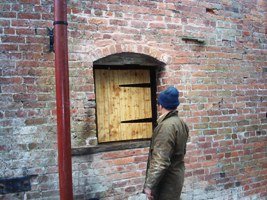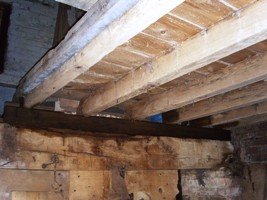Timber Treatment
13th November 2007

Richard started the day fixing hinges to the shutter that he made last week while Colin stood on the waterwheel to remove the last screws from the old hinges. The shutter and the old frame where lavishly treated with clear Cuprinol, the wood preservative that has been recommended to us.
The old wood soaks up this timber treatment at an amazing rate and we are going to get through a tremendous amount. Most of the wood in the mill is exposed, without any paint or other coating, and much of it gets damp as well. So far we are applying it with a brush, but we are going to have to get a sprayer as brushing it on everywhere would just take too long.
When Colin had to leave at lunchtime it was Martyn who took on the fixing of the new shutter hinges to the old frame. The picture was taken as he checked the swing and yes, he was standing on the waterwheel. We had made sure it was firmly anchored so there was no risk of him having to run to keep in place.
John, of course, laid bricks. The last step on the south side of the mill has now been built and the retaining wall between these steps and the farmyard has grown a bit higher. When the book of the restoration is written, and it will be one day, John will have a chapter all to himself.

Kim worked inside the mill all day, a choice that kept him out of the showers. All the new pieces of floorboard were nailed down and treated with Cuprinol. The flooring next to the upstream pair of stones was examined and found to be resting on a beam that was “rotten as a pear”.
This was the part of the floor that we rested one of the millstones on a few weeks ago and we had noticed that it sagged a bit! An acroprop cured the sag on that occasion but it was hardly a permanent solution. Fortunately we do have a limited amount of old timber available and we found a piece that was almost exactly the right size, just a few inches too long.
Two acroprops were put in place and the whole floor lifted half an inch off the rotten beam. The replacement was given a thorough soaking with Cuprinol timber treatment and slid neatly into place. The acroprops were removed and the job was done.
One of the floor joists has also rotted at the end that rested on the rotten beam and also has an extensive crack. By the end of the day we had removed this joist with disturbing the floorboards and were ready to make a replacement.
We are determined to retain as much of the original timber as we possibly can but we have to stop the rot and decay. If anyone would like to donate a hundred litres of Cuprinol Clear it would make a tremendous difference to our budget. This particular timber treatment seems to be the best available balance between environmental concerns and effectiveness as a wood preservative.
Go to the next entry by clicking here.
Read about timber treatment? Click here to see the previous article.
Click here to see how you can support us.
Leave the Shelsey Mill Blog and return Home.